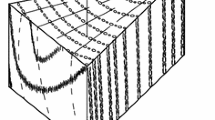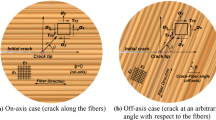Summary
A testing procedure with a new and simple specimen shape is presented which is appropriate to characterize fracturing of inhomogeneous and complex materials like wood. With this, the fracture energy of spruce wood is determined in the TL and RL direction. The “size effect”, i.e. influences of specimen dimensions on KIC and Gf (specific fracture energy) are investigated. Stress and deformation distribution in the newly developed specimens are analysed with FE methods. The measured load-displacement curves are approximated by bilinear softening diagrams and FE analysis. Based on these results, it is tried to interpret typical deviations from LEFM's behaviour by mechanisms like microcracking, crack branching or crack tip bridging.
Similar content being viewed by others
References
Aicher, S.; Reinhardt, H. W. 1993: Einfluß der Bauteilgröße in der linearen und nichtlinearen (Holz-) Bruchmechanik. Holz als Rohund Werkstoff 51: 215–220
Atluri, S. N.; Kobayashi, A. S. 1979: Application of an assumed displacement hybrid finite element procedure to two dimensional problems in fracture mechanics. AIAA/ASME/SAE 15th Structures, Struct. Dyn. and Mater. Conf., Las Vegas, U.S.A.
Barrett 1976: Engng. Fracture Mech. 8: 711–717
Barrett, J. D.; Foschi, R. O. 1977: Mode II stress-intensity factors for cracked wood beams 1977. Engng. Fracture Mech. 9: 371–378
Bazant, Z. P.; Asce, F. 1984: Size effect in blunt fracture: Concrete, rock metal. J. of Engineering Mechanics 110(4): 518–535
Bazant, Z. P.; Pfeiffer, P. A. 1987: Determination of fracture energy from size effect and brittleness number. ACI Materials j., Nov.-Dec.: 463–480
Boatright, S. W. J.; Garrett, G. G. 1983: The effect of microstructure and stress state on the fracture behaviour of wood. J. of Materials Sci. 18: 2181–2199
Benzley, S. E. 1965: Representation of singularity factor in anisotropic bodies. Int. J. Fracture Mech. 1: 189–203
Boström, L. 1986: Analysis of shrinkage cracks in wood by means of fracture mechanics. Div. of Building Materials Lund Institute of Technology, Report TVBM-3O27 Boström, L. 1992: Method for determination of the softening behaviour of wood and the applicability of a nonlinear fracture mechanics model. Universitatis Gothorum, CODEN: LUTVDG/(TVBM-1012)1-132
Cramer, S. M.; McDonald, K. A. 1989: Predicting lumber tensile stiffness and strength with local strain angle measurements and failure analysis. Wood and Fiber Sci. 2(4): 393–410
Ebewele, R. O.; River, B. H.; Koutsky, J. A. 1979: Tapered double cantilever beam fracture tests of phenolic-wood adhesive joints. Wood and Fiber. 12(1): 40–65
Ewing, P.; Williams, J. G. 1979: Thickness and moisture content effect in the fracture toughness of Scots Pine: J. of Materials Science 14: 2959–2966
Foschi, R. O.; Barrett, J. D. 1976: Stress intensity factors in anisotropic plates using singular isoparametric elements. Int. J. Numer. Mech. Engng. 10: 1281–1287
Hillerborg, A. 1991: Application of the fictious crack model to different types of materials. International J. of Fracture 51: 95–102
Hsu, T. C.; Sturman, G. M.; Winter, G. 1962: Microcracking of plain concrete and the shape of the stress-strain curve. ACI Journal Proc., 60(2): 209–222
Kollmann, F. 1951 (reprint 1982): Technologie des Holzes, Springer-Verlag, Berlin, Göttingen, Heidelberg, New York
Kühne, H.; Fischer, H.; Vodoz, J.; Wagner, T. 1955: Über den Einfluß von Wassergehalt, Raumgewicht, Faserstellung und Jahrringstellungen auf die Festigkeit und Verformbarkeit schweizerischen Fichten-, Tannen-, Lärchen-, Rotbuchenund Eichenholzes. Eidg. Mat.prüf.und Vers.anst. für Industrie, Bauwesen und Gewerbe, Zürich, Bericht Nr. 183, Zürich
Murphy, J. F. 1979: Using fracture mechanics to predict failure in notched wood beams. Proc. first internat, conf. on wood fracture, Banff, 1978, Forintek Canada Corp. Vancouver, Canada, 159–173
Nomura, N.; Mihashie, H.; Izumi, M. 1991: Properties of fracture process zone and tension softening behaviour of concrete. In: van Mier, J. G. M.; Rots, J. G.; Bakker, A. (Eds.): Fracture processes in concrete, rock and ceramics, pp. 51–60, London: E&F.N. Spon.
Petterson, H. 1992: Analysis of fracture propagation, COST 508 workshop on fracture mechanics in wooden materials, Bordeaux, France
Petterson, R. O.; Bodig, J. 1983: Prediction of fracture toughness of conifers. Wood and Fiber Sci. 15(4): 302–316
Porter, A. W. 1964: On the mechanics of fracture in wood. For. Prod. J. 14(2): 325–331
Roelfstra, P. E. 1988: Numerical concrete, Ph.D. thesis, ETRH Lausanne
Roelfstra, P. E. 1991: private communication
Saouma, V. E.; Sikiotis, E. S. 1986: Stress intensity factors in anisotropic bodies using singular isoparametric elements. Eng. Fract. Mech. 25, 1: 115–121
Schniewind, A. P. 1962: Tensile strength perpendicular to grain as a function of moisture content in California Black oak: Forest Products J. 12(5): 249–252
Schniewind, A. P. 1989: Concise encyclopedia of wood and wood-based materials, ed. Schniewind A. P., Pergamon, Oxford, p. 77
Schniewind, A. P.; Centeno, J. C. 1982: Fracture toughness and duration of load factor I. Six principal systems of crack propagation and the duration factor for cracks propagating parallel to grain. Wood and Fiber 5(2): 152–159
Schniewind, A. P.; Ohgama, T.; Aoki, T.; Yamada, T. 1982: Effect of specific gravity, moisture content, and temperature on fracture toughness of wood: Wood Science 15/2, 101–109
Schniewind, A. P.; Pozniak, R. A. 1971: On the fracture toughness of Douglas Fir wood: Engng. fract. mechanics 2: 223–233
Sih, G. C.; Paris, P. C.; Irwin, G. R. 1965: On cracks in rectilineary anisotropic bodies using singular isoparametric elements. Int. J. Fracture Mech. 1: 189–203
Stanzl-Tschegg, S. E.; Tschegg, E. K.; Teischinger, A. 1993: Fracture energy of Spruce wood after different drying procedures. Wood and Fiber Science, accepted
Teischinger, A. 1992: Der Einfluß des Trocknungsverfahrens auf ausgewählte Holzkennwerte, Teil 2: Holzforschung und Holzverwertung, 44, 5: 83–86
Triboulot, P.; Jodin, P.; Pluvinage, G. 1984: Validity of fracture mechanics concepts applied to wood by finite element calculation. Wood Sci. and Techn. 51–57
Tschegg, E. K. 1986: Patent AT-390328: Prüfeinrichtung zur Ermittlung von bruchmechanischen Kennewertensowie hiefür geeigneter Prüfkörper
Tschegg, E. K. 1990: Patent AT-396997: Lasteinleitungsvorrichtung
Tschegg, E. K. 1991: New equipments for fracture tests in concrete. Mat. Prüf 33: 338–342
Tschegg, E. K.; Hummer, K.; Weber, W. 1993: Fracture test in Mode I on fiber reinforced plastics: J. of Mat. Sci. 28, 2471–2480
Tschegg, E. K.; Tan, D. M.; Stanzl-Tschegg, S. E. 1993: Development and experience with the wedge splitting test. Submitted to ASTM Testing and Evaluation
Valentin, G.; Adjanohoun, 1992: Applicability of classical isotropic fracture mechanics specimens to wood crack propagation studies. Materials and Struct. 25: 3–13
VanMier, G. G. M. 1991: Mode I fracture of concrete: discontinuous crack growth and crack interface grain bridging. Cement and Concrete Research, 21, Perg. Press, USA, 1–15
Zikmunda, W. 1992: Bruchmechanische Charakterisierung des Haftvemögens zementgebundener Werkstoffe. Ph.D. thesis TU Wien
Author information
Authors and Affiliations
Additional information
The authors thank Dr. A. Teischinger for supplying the testing material and Dipl. Ing M. Elser for preparation of the diagrams. Financial support of the Fonds zur Förderung der wissenschaftlichen Forschung, Wien is gratefully acknowledged.
Rights and permissions
About this article
Cite this article
Stanzl-Tschegg, S.E., Tan, DM. & Tschegg, E.K. New splitting method for wood fracture characterization. Wood Sci.Technol. 29, 31–50 (1995). https://doi.org/10.1007/BF00196930
Received:
Issue Date:
DOI: https://doi.org/10.1007/BF00196930




